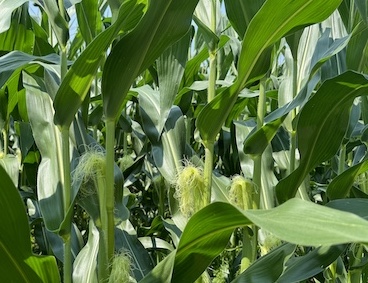Late-July Crop Perspectives
Jul 31, 2024

Craig Loen, Federated ag sales rep from the Osceola location, took time last week to assess crop development and share valuable perspectives.
Both corn and soybeans are in the reproductive stages, but there were also crops that didn’t get planted until the early days of July due to heavy rains.
Loen noted that planting dates were all over the board and GDUs vary greatly. Earlier plantings have seen as many as 100 more GDU’s than crops planted a week later.
The “rains were plentiful in most of [Federated’s] geographies,” said Loen, and in the Osceola area in particular, 18 inches of rain had fallen between May 10 and now – about double the 10-year average for that period.
The rains took their toll on preplant nitrogen (N) and sulfur (S) applications, two nutrients that are “very mobile in the soils.” Consequently, there is a good deal of pale, yellow corn in the area due to N deficiency – the corn roots simply cannot catch the nutrients as the water moves them through the soil profile. Soybeans may be sulfur deficient for the same reasons.
Loen warned that corn leaf disease and tar spot have been found in south central Minnesota (and it’s not clear how far north that will go). Soybeans are susceptible to white mold with the hot humid days recently. Fungicide applications can help manage these late-season diseases. Loen also noted the need to watch for yield-robbing soybean aphids – and treat accordingly.
Your Federated Agronomists are ready to help with late-season crop issues. Give them a call.
Both corn and soybeans are in the reproductive stages, but there were also crops that didn’t get planted until the early days of July due to heavy rains.
Loen noted that planting dates were all over the board and GDUs vary greatly. Earlier plantings have seen as many as 100 more GDU’s than crops planted a week later.
The “rains were plentiful in most of [Federated’s] geographies,” said Loen, and in the Osceola area in particular, 18 inches of rain had fallen between May 10 and now – about double the 10-year average for that period.
The rains took their toll on preplant nitrogen (N) and sulfur (S) applications, two nutrients that are “very mobile in the soils.” Consequently, there is a good deal of pale, yellow corn in the area due to N deficiency – the corn roots simply cannot catch the nutrients as the water moves them through the soil profile. Soybeans may be sulfur deficient for the same reasons.
- N deficiency is particularly evident in the lower leaves of the plants, with “V” shape yellowing from the center of the leaves outward.
- S deficiency causes pale, “almost see-through,” leaves at the top of the plants.
Loen warned that corn leaf disease and tar spot have been found in south central Minnesota (and it’s not clear how far north that will go). Soybeans are susceptible to white mold with the hot humid days recently. Fungicide applications can help manage these late-season diseases. Loen also noted the need to watch for yield-robbing soybean aphids – and treat accordingly.
Your Federated Agronomists are ready to help with late-season crop issues. Give them a call.